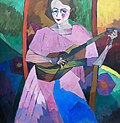Aristarkh Lentulov
Russian artist (1882-1943) From Wikipedia, the free encyclopedia
Remove ads
Aristarkh Lentulov [1] (4 January 1882 – 15 April 1943) was a major Russian avant-garde artist who also worked on set designs for the theatre. His work shows strong influences of fauvism and cubism.[2][3]

Biography
Aristarkh Lentulov was born in Penza Oblast, 625 kilometers (388 mi) southeast of Moscow, into the family of a country priest. He studied art in the Penza and Kiev art schools from 1897 to 1905. Then he went to the private studio of Dmitry Kardovsky in St Petersburg in 1906.
He lived in Moscow from 1909, and he was one of the founders of the avant-garde Knave of Diamonds (Jack of Diamonds) group.
From 1910 to 1911 Lentulov studied at the Le Fauconnier studio and the La Palette Academy in Paris. While there, he met contemporary French painters such as Albert Gleizes, Jean Metzinger, Fernand Léger and Robert Delaunay. He took in the fauvists' and cubists' principles, and developed his own colourful style of painting. Later, after his return to Russia in 1912, he became a big influence on what became Russian futurism. Wassily Kandinsky and Kazimir Malevich were both influenced by him. [4]
Lentulov also formed another group, with Vladimir Mayakovsky and Kazimir Malevich, called Today's Lubock (Segodnyashnii Lubok). They produced satire art that was anti-Austria and anti-Germany. The art pulled inspiration from Russian folklore and lubok art. Lentulov's own art was heavily inspired by traditional and folk Russian architecture. [5]
From Russian Revolution of 1917 times, Lentulov was actively involved in various theatrical projects, designing for plays in the Kamerny Theatre (The Merry Wives of Windsor, 1916) and contributing sets for a production of Alexander Scriabin's Prometheus in the Bolshoi Theatre in 1919. [6]
In 1928 Lentulov entered into the Society of Moscow artists, and became chairman of the Society. He also started teaching at the Russian State Art and Technical School.
Lentulov died in Moscow and is buried in the Vagankovo Cemetery.
Remove ads
Gallery
- Skybell (Nebozvon)
- Woman with Guitar, 1913
- Portrait of Artist's Wife and Daughter, 1915
- Tverskoi Boulevard , 1917
- Compositio allegorica Spes. Series anni "1812" . 1915.
- Compositio allegorica cum Gallina, Series anni "1812" (1915)
- "Montes Kislovodsk", 1913
- Theater Artist Aleksandra Khokhlova, 1919
Related pages
References and sources
Other websites
Wikiwand - on
Seamless Wikipedia browsing. On steroids.
Remove ads








